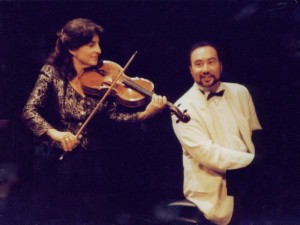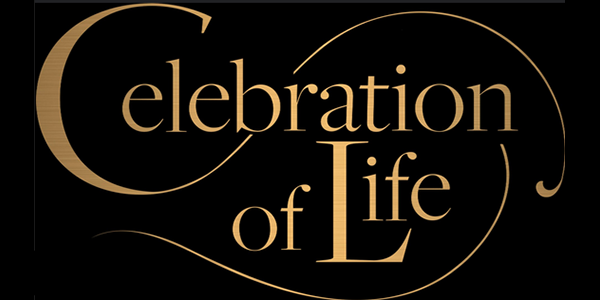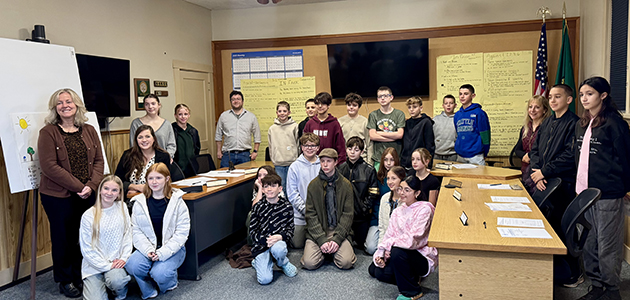
Orcas Island Chamber Music Festival Founder and Artistic Director Aloysia Friedmann and Artistic Advisor Jon Kimura Parker, at the inaugural festival in 1998.
The Quintessential Quintets concerts will bring to a close the 2010 Orcas Island Chamber Music Festival season. In the performances on Friday, Aug. 27 and Saturday, Aug. 28, the talents of classical guitarists [intlink id=”9712″ type=”post”]Eliot Fisk and his wife Zaira Meneses[/intlink], of the [intlink id=”9699″ type=”post”]Miró Quartet[/intlink], and of Chamber Festival musicians – violinists [intlink id=”9699″ type=”post”]Chee-Yun[/intlink] and Martin Chalifour, cellist Toby Saks, violist Aloysia Friedmann and pianist John Kimura Parker will be employed.
At a talk given to Music Lovers Seminar attendees this week, classical guitarist Eliot Fisk said, “I’m in complete awe of what’s been created at the Orcas Chamber Music Festival. We’ve been to many music festivals, and we’ve never experienced anything like the seamless organization, but also the humanity, warmth and generosity we’ve found here. It’s not just important for the art of music, but in the bigger picture.
“We’ve traveled a lot and spent a lot of time outside the U.S. , and we appreciate the uniquely American aspect of this festival. In America, we’re supposedly at each others’ throats, but we look around and get a grip and see how good we’ve got it: this is what a free people does!”
The “Quintets” will be:
- Balada’s Homage to Federico García Lorca, 20th century poet and playwright and casualty of the Spanish Civil War, which concludes the first part of the concert;
- Schumann’s Quintet for Piano and Strings in E-flat Major, Op. 44, concluding the concert and the Festival.
The first part of the Quintessential program offers compositions mostly by United States’ and South American composers who explored various routes in their compositions from the romanticism of the 19th century through jazz, tango, folk and classical routes.
Che-Yun and Zaira Meneses will begin the concert, playing violin and guitar respectively on Eliot Fisk’s award-winning arrangements of American folksongs, Mountain Songs by Robert Beaser.
Piazzolla History of the Tango for violin and guitar, will also be performed by Chee-Yun and Zaira.
Ástor Pantaleón Piazzolla was an Argentine tango composer and bandoneón (which Fisk described as “a plaintive, nuanced accordian.” His work changed the traditional tango into a new style termed Nuevo tango, incorporating elements from classical music and jazz. A virtuoso bandoneónist, he regularly performed his own compositions with different ensembles
Piazzolla was born in Argentinain 1921 to Italian parents, but he spent most of his childhood with his family in New York City, where he was exposed to both jazz and the music of J.S. Bach at an early age. He began to play the bandoneón after his father, nostalgic for his homeland, spotted one in a New York pawn shop and was a virtuoso player of that instrument from his early teen years.
He returned to Argentina in 1937, where strictly traditional tango still reigned, and played in night clubs with a series of groups. The pianist Arthur Rubinstein, then living in Buenos Aires, advised him to study with the Argentine composer Ginastera. He studied the work of Stravinsky, Bartók and others, rose early each morning to hear the Teatro Colón orchestra rehearse, and still maintained a grueling performance schedule in the tango clubs at night.
At Ginastera’s urging, in 1953 Piazzolla entered his Buenos Aires Symphony in a composition contest, and won a grant from the French government to study in Paris with the legendary French composition teacher Nadia Boulanger. In 1954 he and his first wife, the artist Dedé Wolff, left Buenos Aires and their two children behind and travelled to Paris. The insightful Boulanger turned Piazzolla’s life around in a day, as he recounts in his Memoir:
When I met her, I showed her my kilos of symphonies and sonatas. She started to read them and suddenly came out with a horrible sentence: “It’s very well written.” And stopped, with a big period, round like a soccer ball. After a long while, she said: “Here you are like Stravinsky, like Bartók, like Ravel, but you know what happens? I can’t find Piazzolla in this.” And she began to investigate my private life: what I did, what I did and did not play, if I was single, married, or living with someone, she was like an FBI agent! And I was very ashamed to tell her that I was a tango musician. Finally I said, “I play in a night club.” I didn’t want to say cabaret. And she answered, “Night club, mais oui, but that is a cabaret, isn’t it?” “Yes,” I answered, and thought, “I’ll hit this woman in the head with a radio….” It wasn’t easy to lie to her.
She kept asking: “You say that you are not pianist. What instrument do you play, then?” And I didn’t want to tell her that I was a bandoneón player, because I thought, “Then she will throw me from the fourth floor.” Finally, I confessed and she asked me to play some bars of a tango of my own. She suddenly opened her eyes, took my hand and told me: “You idiot, that’s Piazzolla!” And I took all the music I composed, ten years of my life, and sent it to hell in two seconds.
Piazzolla returned from New York to Argentina the next year, formed the Octet Buenos Aires with violins, piano, bandoneón, cello, bass and electric guitar, “and never looked back.” (Wikipedia).
Piazzolla’s nuevo tango was distinct from the traditional tango in its incorporation of elements of jazz, its use of extended harmonies and dissonance, its use of counterpoint, and its ventures into extended compositional forms. Some of his innovations were:
- the use of the passacaglia, a technique of a circulating bass line and harmonic sequence, invented and much used in 17th and 18th century baroque music but also central to the idea of jazz “changes”
- complex and virtuosic counterpoint that allows each performer in the group to assert his voice.
- improvisation that “involves a different vocabulary of scales and rhythms that stay within the parameters of the established tango sound-world.”
The quintet formed by bandoneón, violin, piano, electric guitar and double bass was Piazzolla’s preferred instrumental grouping and most critics consider it to be the most successful instrumentation for his works. This is due partly to its great efficiency in terms of sound – it covers or imitates most sections of a symphony orchestra, including the percussion which is improvised by all players on the bodies of their instruments – and the strong expressive identity it permits each individual musician. (Wikipedia)
Upon introducing nuevo tango, he became a controversial figure among Argentines both musically and politically. The Argentine saying “in Argentina everything may change — except the tango” suggests some of the resistance he found in his native land. However, his music gained acceptance in Europe and North America, and his reworking of the tango was embraced by some liberal segments of Argentine society, who were pushing for political changes in parallel to his musical revolution. During the period of Argentine military dictatorship from 1976 to 1983, Piazzolla lived in Italy, but returned many times to Argentina.
Piazzolla consistently experimented with other musical forms and instrumental combinations. In 1965 an album was released containing collaborations between Piazzolla and Jorge Luis Borges, where Borges’s poetry was narrated over very avant-garde music by Piazzolla.
In 1968 he wrote and produced an “operita,” Maria de Buenos Aires, that employed a larger ensemble including flute, percussion, multiple strings and three vocalists, and juxtaposed movements in Piazzolla’s own style with several pastiche numbers ranging from waltz and hurdy-gurdy to a piano/narrator bar-room scene straight out of the movie, Casablanca.
He developed a leaner, more fluid musical style drawing on more jazz influence, and with simpler, more continuous forms. He gained the financial security to become relatively autonomous artistically, and wrote some of his most ambitious multi-movement works. These included the Quintessential concert’s Histoire du Tango, with the history of tango told in four “chunks of music styled at thirty-year intervals.” (Wikipedia)
Castelnuovo-Tedesco Fantasia for guitar and piano is “an unusual combination,” says OICMF Artistic Director Aloysia Friedmann, and will be performed by Zaira Meneses on guitar and Jon Kimura Parker on piano. The Fantasia was written by Castelnuovo-Tedesco for classical guitar icon Andrés Segovia and his wife, who was a pianist.
Mario Castelnuovo-Tedesco (1895 –1968) was born in Florence, the descendant of a prominent banking family that had lived in the city since the expulsion of Jews from Spain in 1492. Castelnuovo-Tedesco was first introduced to the piano by his mother, and he composed his first pieces when he was just nine years old. He received a diploma in composition in 1918. His early work was included in the first festival of the International Society of Contemporary Music, held in Salzburg, Austria in 1922.
In 1926, Castelnuovo-Tedesco premiered his opera, La Mandragora, based on a play by Machiavelli. He composed many works inspired by great literature, including interpretations of works by Aeschylus, Virgil, Keats, Wordsworth, Whitman, García Lorca and Shakespeare. Another major source of inspiration for him was his Jewish heritage, most notably the Bible and Jewish liturgy. His Violin Concerto no. 2 (1931), written at the request of Jascha Heifetz, was also an expression of his pride in his Jewish origins, or as he described it, the “splendor of past days,” in the face of rising anti-Semitism that was sweeping across much of Europe.
Shortly thereafter, Castelnuovo-Tedesco first met the Spanish guitarist Andrés Segovia, and wrote his Guitar Concerto no. 1, one of the first of almost one hundred compositions for that instrument, which earned him the reputation as one of the foremost composers for then guitar in the twentieth century.
The following year the Italian fascist government developed a program toward the arts, which were viewed as a tool for the promotion of racial ideas. Even before Mussolini officially adopted the Manifesto of Race in 1938, Castelnuovo-Tedesco was banned from radio and performances of his work were cancelled. The new racial laws, however, convinced him that he should leave Italy. Like many artists who fled fascism, Castelnuovo-Tedesco ended up in Hollywood, where he was a film composer. Over the next fifteen years, he worked on scores for some 200 films there and at the other major film studios. He was a significant influence on other major film composers, including Henry Mancini, Nelson Riddle, Herman Stein and André Previn. Jerry Goldsmith, Marty Paich and John Williams were all his pupils.
He also composed new operas (The Merchant of Venice and The Importance ofBeing Earnest) and works based on American poetry, Jewish liturgy, and the Bible. (Wikipedia)
Eliot Fisk will then perform works by Agustín Pío Barrios–Mangore (1885 –1944), a Paraguayan composer who was featured in OICMF performance earlier this season by Zaira Meneses in the Fandango concerts.
As a child, Barrios developed a love for music and literature; he showed a particular interest in the guitar at an early age, entering the National University at the age of 15 with a scholarship in music. He also shone in the college’s mathematics, journalism and literature departments. After leaving college, Barrios dedicated his life to music and writing poems. He composed more than 300 songs for which he would first write the lyrics and then the guitar accompaniment. He was famed for his phenomenal performances, both live and recorded.
John Williams has said of Barrios: “As a guitarist/composer, Barrios is the best of the lot, regardless of era. His music is better formed, it’s more poetic, it’s more everything! And it’s more of all those things in a timeless way.”
Barrios’s compositions can be divided into three basic categories: folkloric, imitative and religious. His works were largely late-romantic in character, despite his having lived well into the twentieth century. Many of them are also adaptations of, or are influenced by, South American and Central American folk music. (Barrios claimed indigenous ancestry, of the Guarani people).
Imitating the compositional style and techniques of the Baroque and Romantic periods was another side to his craftsmanship. The Bach-inspired La Catedral (1921) is often considered to be his most impressive work; Andrés Segovia described its second movement as “a very virtuosic piece which is ideal for the repertory of any concert guitarist.” (Wikipedia)
Balada Caprichos No. 1 for guitar and string quartet (Homage to Frederico Garcia Lorca) is a suite of seven short pieces using Andalucian folk ideas. Ballad to Frederico García Lorca, the Spanish playwright killed in the Spanish Civil War of the 1930s, was commissioned by the Austin Classical Guitar Society and had its world premiere in 2006 with Eliot Fisk and the Miró String Quartet.
Leonardo Balada was born in Barcelona, Spain, and traveled to New York to further his music education at the Juilliard School. He says, “When I landed in New York to study composition- a freezing day in March of 1956 — little did I know of the mental turmoil I would experience in the next few years. That city had become the focal point for the latest music and arts. Those experiences in New York shook my musically conservative upbringing to its roots.” (From the website www.balada.com )
He studied composition with Vincent Percichetti, Aaron Copland and conducting with Igor Markevitch. Since 1970 he has been teaching at Carnegie Mellon University in Pittsburgh, Pennsylvania, where he is University Professor of Composition.
Some of his best known works were written in a dramatic avant-garde style in the sixties (Guernica, María Sabina, Steel Symphony). He is credited with pioneering a blending of ethnic music with those avant-garde techniques later on, creating a very personal style including Sinfonía en Negro-Homage to Martin Luther King from 1968. Balada has received several international awards; his works are performed by the world’s leading orchestras and his work is commissioned internationally as well. He says:
For my part, I felt a strong necessity to become up to date aesthetically, to look to the future and not be criticized as a reactionary. How could it be otherwise for a liberal young fellow brought up in Spain, opposed to Franco’s conservatism? On the other hand the music I was listening to in New York was not for me. The strict rules of serial techniques were not fitting with my personality while on the other hand, the free-open ‘aleatoric’ techniques seemed to me capricious.
Actually the visual arts in New York become my source of ideas to find my new style. From Rauschemberg to the happenings of the time and also Salvador Dali, with whom I was then collaborating, all helped in conceiving my new strategy of sound.
The compositions that started my new style — my second period — were Geometrias n. 1 for ensemble and Guernica for orchestra. That was a 180 degrees turn-around. I had found my own language based on concepts that dealt with space, dots, lines, electronic effects produced by live instruments, extreme dynamic contrasts, dense textures, but always propelled by a constant rhythm and pulse … There were not either cold, calculated musical expressions like the ones I used to hear and hate constantly at the MacMillan Theater of Columbia University, intellectual and musical showplace at that time. This was an important step for me, for on finding my own voice in the “avant-garde” I got back my pride and confidence.
During the decade of my abstract expression… I was watching closely thematic and ethnic ideas. From my point of view, there was no reason not to reintroduce traditional ideas as long as those were presented in a fresh perspective. That meant to me the using of “avant-garde” techniques.
Although in my Sinfonía en Negro (1968) I introduced some African-ethnic ideas on top of the “avant-garde,” it was not until I composed “Homage to Casals and Sarasate” (1975) that I started what could be construed as my third period. Here one sees traditional thematic, harmonic and folkloric ideas without rejecting the adventures of new and fashionable techniques. In this new period a symbiosis of the “avant-garde” and the traditional exists.
Is it time for me to move towards a forth period? I am working on it… and it may be called Surrealism as in Salvador Dali’s brand of surrealism, in which a “real” image is transformed into something similar but different.
In truth the world is much more open than it was not so many years ago… One can no longer speak of music in absolute terms. For me, though, things are very clear in judging a composition. Has the work personality, is it professional, does it creates an impact? In this world where one looks constantly for the comfortable and the immediate, in which the muscles degenerate due to easy living and the mind is mesmerized by the visual shows and TV, the answer is not easy, for those concepts are not often sought or appreciated. (From the website www.leonardobalada.com )
Following the intermission, the Quintessential concerts turn to the European composers, with compositions by Albéniz, Chopin and Tárrega arranged by Eliot Fisk, before the season finale with Schumann’s Quintet for Piano and Strings.
Albéniz Córdoba and Torre Bermeja for solo guitar are arranged and performed by Eliot Fisk.
Isaac Manuel Francisco Albéniz y Pascual (1860- 1909) was a Spanish pianist and composer best known for his works based on folk music. He was a child prodigy who first performed at the age of four. At age seven, he passed the entrance examination for piano at the Paris Conservatoire, but he was refused admission because he was believed to be too young. His concert career began at the young age of nine when his father toured both Isaac and his sister throughout northern Spain.
As a teenager, Albéniz performed in Cuba, New York, San Francisco, Liverpool, London and Leipzig. At the age of 23 he began to write Spanish music, such as the Chants d’Espangne. The first movement (Prelude) of that suite, later retitled after the composer’s death as Asturias (Leyenda), is probably most famous today as part of the classical guitar repertoire, even though it was originally composed for piano and only later transcribed.
In 1883, Albéniz met the teacher and composer Felipe Pedrell, who was a leading figure in the development of nationalist Spanish music. Gilbert Chase, in his book The Music of Spain, describes Pedrell’s influence on Albéniz: “What Albéniz derived from Pedrell was above all a spiritual orientation, the realization of the wonderful values inherent in Spanish music.” (Wikipedia)
In 1900 he started to suffer from Bright’s disease, and returned to writing piano music. Between 1905 and 1908 he composed his final masterpiece, Iberia, a suite of twelve piano “impressions.”
Perhaps the best source on his work is Albéniz himself. He is quoted:
“I believe that the people are right when they continue to be moved by Cordoba, Mallorca, by the copla of the Sevillanas, by the Serenata, and Granada. In all of them I now note that there is less musical science, less of the grand idea, but more color, sunlight, flavor of olives. That music of youth, with its little sins and absurdities that almost point out the sentimental affectation…appears to me like the carvings in the Alhambra, those peculiar arabesques that sway nothing with their turns and shapes, but which are like the air, like the sun, like the blackbirds or like the nightingales of its gardens. They are more valuable than all else of Moorish Spain, which though we may not like it, is the true Spain.”
Chopin Three Waltzes, originally composed for piano, now arranged by Eliot Fisk for two guitars and performed by Eliot and Zaira. As Jeff O’Kelly explains in the program notes, “two guitars… can share the music, roughly employing a division of the right- and left-hand parts for the piano. The results are far more idiomatic and satisfying.”
Frédéric Chopin was a renowned child prodigy pianist and composer. He spent most of his childhood in Warsaw and completed his musical education there. Following the Russian suppression of the Polish November 1830 uprising, Chopin settled in France as part of the Polish Great Emigration. In Paris he supported himself as a composer and piano teacher, giving few public performances. He was known for his innovative style of performance, never playing a piece exactly as written.
After romantic involvements with several Polish women, from 1837 to 1847 he carried on a relationship with the French novelist Amantine Aurore Lucie Dupin, baronne Dudevant, better known by her pseudonym, George Sand. For the greater part of his life, Chopin suffered from poor health. He died in Paris, aged 39, of what was diagnosed as tuberculosis but has since been argued to have been cystic fibrosis.
The majority of Chopin’s compositions were written for solo piano; all his extant works feature the piano in one way or another. They are technically demanding but emphasize nuance and expressive depth. Chopin invented musical forms such as the instrumental ballade and made major innovations to the piano sonata, mazurka, waltz, nocturne, polonaise, étude, impromptu and prélude. (Wikipedia)
In Chopin’s day, which came before that of Johann Strauss, the waltz was not the “elegant sophisticated dance … but something closer to café music.” (Libbey). However, the Waltz in E flat, Gran Valse Brilliante, to be played in the Quintessential concerts, is considered exceptionally gracious.
Francisco Tárrega Recuerdos de la Alhambra for two guitars, are arranged by Fisk and performed by him and his wife, Zaira.
Tárrega was an influential Spanish composer and guitarist of the Romantic era. In addition, he transcribed the work of others to guitar, among them the compositions of Isaac Albéniz. Albéniz once declared that he preferred Tárrega’s guitar transcriptions to his original piano works.
Tárrega was born in 1852, in the Castellon province of Spain. His father’s guitar was an early “toy” and after an infection permanently impaired his eyesight, he was enrolled in music classes. Both his first music teachers, Eugeni Ruiz and Manuel González, were blind.
In 1862, concert guitarist Julian Arcas, on tour in Castellón, heard the young Tárrega play and advised Tárrega’s father to allow Francisco to come to Barcelona to study with him. Tárrega’s father agreed, but Tárrega had to stop his lessons shortly after, when Arcas left for a concert tour abroad. Although Tárrega was only ten years old, he ran away and tried to start a musical career on his own by playing in coffee houses and restaurants in Barcelona. He was soon found and brought back to his father, who had to make great sacrifices to advance his son’s musical education.
Three years later, in 1865, he ran away again, this time to Valencia where he joined a gang of gypsies. His father looked for him and brought him back home once more, but he ran away a third time, again to Valencia. By his early teens, Tárrega was proficient on both the piano and the guitar. For a time, he played with other musicians at local engagements to earn money, but eventually he returned home to help his family.
Tárrega entered the Madrid Conservatory in 1874, under the sponsorship of a wealthy businessman. At the conservatory, Tárrega studied composition and was encouraged to focus on guitar and abandon the idea of a career with the piano. By the end of the 1870s, Tárrega was teaching the guitar and giving regular concerts throughout Spain; he was also composing his first works for guitar, which he played in addition to works of other composers.
His concerts took him to France and England, where he captured a moment of loneliness in one of his most memorable works, Lágrima (Teardrop). To enlarge his guitar repertory, he soon began transcribing piano works of Beethoven, Chopin, and others. On a concert tour, Tárrega met a wealthy widow, Conxa Martinez, who became a valuable patron to him. She allowed him and his family use of a house in Barcelona, where he would write the bulk of his most popular works. Later she took him to Granada, where the guitarist conceived the theme for his famous Recuerdos de la Alhambra . (Wikipedia)
In the Quintessential concerts, the audience will hear a second part in this piece, written by Fisk.
Tárrega is considered to have laid the foundations for 20th century classical guitar and for increasing interest in the guitar as a recital instrument. He was central to reviving the guitar as a solo instrument in recital and concerts. His output was modest, having composed only 78 original scores and 120 transcriptions – mostly for his own use.
He is also the composer of what has been claimed to be “probably the world’s most heard tune” — the Nokia cell phone ringtone, also used in advertising spots, is based on Tárrega’s Gran Vals. (Wikipedia)
Schumann Piano Quintet in E-flat Major will be performed by Martin Chalifour and Chee-Yun on violin, Aloysia Friedmann on viola, Toby Saks on cello, and Jon Kimura Parker on piano.
In describing her programming efforts for this season, Aloysia said, “I knew I wanted to end with the Schumann Piano Quintet – it’s an exciting ending – joyous, brilliant, everyone loves it!”
This composition is described by Ted Libbey of National Public Radio’s Performance Today, as a “seminal work, the first in a long line of Romantic piano quintets that includes essays by Brahms, Dvorak and Franck.”
As Jeff O’Kelly says in the OICMF Program Notes, the Schumann Piano Quintet is written in the key of E-flat Major “which, ever since Beethoven’s Eroica symphony, has been associated with all things heroic.”
Schumann dedicated the Piano Quintet to his wife Clara, a renowned concert pianist, but illness prevented her from participating in the work’s first performance in Leipzig. Instead, Felix Mendelssohn, who had been invited to the Quintet’s premiere, gamely sight-read the piece. (Libbey)
The OICMF will be represented on the National Public Radio Series, “American Music Festivals,” in 2011. The program is funded by the National Endowment for the Arts, and will be a two-hour broadcast of this season’s program.
The program will feature not only the music, Aloysia says, but also “the flavor of what we’ve done in the community, how it was built up, why it’s so important in the community. There are so many exciting things to capture!”
Quintessential Quintets Sponsors
Pamela Loew and Linda Henry are the sponsors of the August 27 concert at 7:30 p.m. Rachel Adams will sponsor the reception following the concert. On Saturday, August 28, Valerie and William Anders sponsor the Quintessential Quintets concert. Christine Chandler and James Connell provide the post-concert reception.
Waiting List policy
OICMF Executive Director Victoria Parker says, “A very productive waiting list is offered for each concert (with the exception of the Children’s Concert). When tickets become available through returns or traded nights, staff will call those on the Waiting List in the order of their inclusion.
“Every reasonable effort will be made to contact those on the list. Approximately 30 minutes before a concert begins, the waiting list will be abandoned and hopeful patrons waiting in the lobby will be offered any tickets that are still available. Seats that are not occupied by Intermission will be resold at a reduced price.”
Tickets may be purchased at www.oicmf.org or by calling 360-376-6636 or toll-free at 866-492-0003.
**If you are reading theOrcasonian for free, thank your fellow islanders. If you would like to support theOrcasonian CLICK HERE to set your modestly-priced, voluntary subscription. Otherwise, no worries; we’re happy to share with you.**








What a gift! THANK YOU for this article, Margie. I missed the music lover’s seminar, then discovered there was no pre-concert talk, then started searching the web….When I found you had done all the work for me, and I could print it out and relax and enjoy my own little pre-concert seminar at home, I was delighted. Makes me want to read everything you compile for future concerts. Many many thanks Margie. Off to the concert, now!